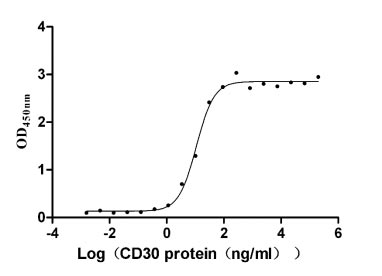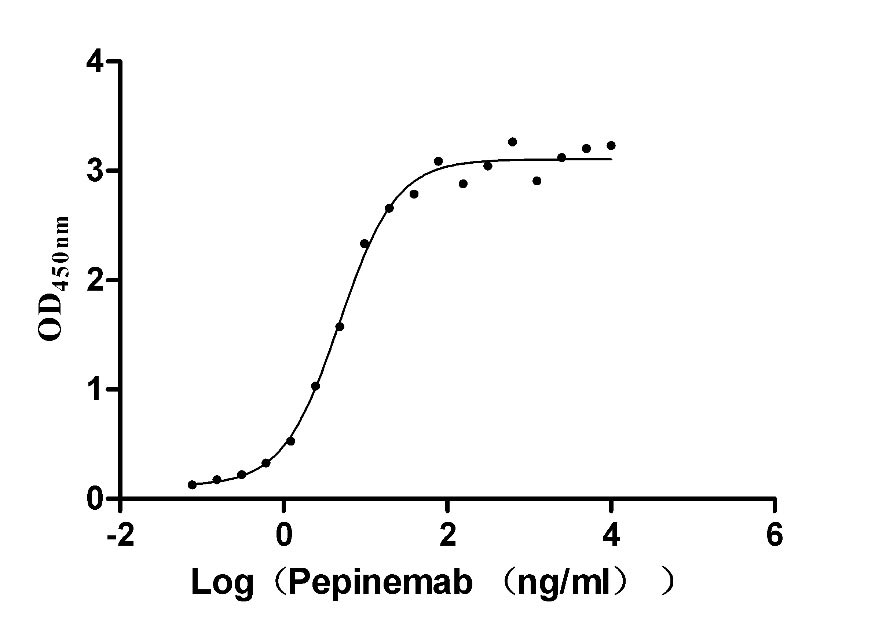Recombinant Mouse C-X-C chemokine receptor type 1 (Cxcr1), partial
-
货号:CSB-YP800386MO1
-
规格:
-
来源:Yeast
-
其他:
-
货号:CSB-EP800386MO1
-
规格:
-
来源:E.coli
-
其他:
-
货号:CSB-EP800386MO1-B
-
规格:
-
来源:E.coli
-
共轭:Avi-tag Biotinylated
E. coli biotin ligase (BirA) is highly specific in covalently attaching biotin to the 15 amino acid AviTag peptide. This recombinant protein was biotinylated in vivo by AviTag-BirA technology, which method is BriA catalyzes amide linkage between the biotin and the specific lysine of the AviTag.
-
其他:
-
货号:CSB-BP800386MO1
-
规格:
-
来源:Baculovirus
-
其他:
-
货号:CSB-MP800386MO1
-
规格:
-
来源:Mammalian cell
-
其他:
产品详情
-
纯度:>85% (SDS-PAGE)
-
基因名:
-
Uniprot No.:
-
别名:Cxcr1; Il8ra; C-X-C chemokine receptor type 1; CXC-R1; CXCR-1; High affinity interleukin-8 receptor A; IL-8R A; CD antigen CD181
-
种属:Mus musculus (Mouse)
-
蛋白长度:Partial
-
蛋白标签:Tag type will be determined during the manufacturing process.
The tag type will be determined during production process. If you have specified tag type, please tell us and we will develop the specified tag preferentially. -
产品提供形式:Lyophilized powder
Note: We will preferentially ship the format that we have in stock, however, if you have any special requirement for the format, please remark your requirement when placing the order, we will prepare according to your demand. -
复溶:We recommend that this vial be briefly centrifuged prior to opening to bring the contents to the bottom. Please reconstitute protein in deionized sterile water to a concentration of 0.1-1.0 mg/mL.We recommend to add 5-50% of glycerol (final concentration) and aliquot for long-term storage at -20℃/-80℃. Our default final concentration of glycerol is 50%. Customers could use it as reference.
-
储存条件:Store at -20°C/-80°C upon receipt, aliquoting is necessary for mutiple use. Avoid repeated freeze-thaw cycles.
-
保质期:The shelf life is related to many factors, storage state, buffer ingredients, storage temperature and the stability of the protein itself.
Generally, the shelf life of liquid form is 6 months at -20°C/-80°C. The shelf life of lyophilized form is 12 months at -20°C/-80°C. -
货期:Delivery time may differ from different purchasing way or location, please kindly consult your local distributors for specific delivery time.Note: All of our proteins are default shipped with normal blue ice packs, if you request to ship with dry ice, please communicate with us in advance and extra fees will be charged.
-
注意事项:Repeated freezing and thawing is not recommended. Store working aliquots at 4°C for up to one week.
-
Datasheet :Please contact us to get it.
相关产品
靶点详情
-
功能:Receptor to interleukin-8, which is a powerful neutrophils chemotactic factor. Binding of IL-8 to the receptor causes activation of neutrophils. This response is mediated via a G-protein that activate a phosphatidylinositol-calcium second messenger system.
-
基因功能参考文献:
- these studies define CXCR1 as a novel, noncanonical chemokine receptor that regulates pulmonary anti-Pseudomonas host defense with broad implications for cystic fibrosis, chronic obstructive pulmonary disease and other infectious lung diseases PMID: 26950764
- CXCR1 and CXCR2 regulate hepatocyte exosome release. The mechanism utilized by CXCR1 remains elusive, but CXCR2 appears to modulate Nsm activity and resultant production of ceramide to control exosome release. CXCR1 is required for packaging of enzymes into exosomes that mediate their hepatocyte proliferative effect. PMID: 27551720
- These data demonstrate a biological function for mouse Cxcr1 in vivo and indicate that CXCR1-dependent neutrophil effector function is a critical innate protective mechanism of fungal clearance and host survival in systemic candidiasis. PMID: 26791948
- in view of recently-published experimental data obtained in NOD mice, we argue for possible Cxcr1 involvement in type 1 diabetes pathogenesi PMID: 26230114
- expressed 33-110-fold higher in hepatocellular carcinoma polymorphonuclear myeloid-derived suppressor cells PMID: 25891236
- CXCR1 expression is induced in staphylococcus aureus-infected macrophages but not in control macrophages. PMID: 25129059
- Pharmacologic blockade of CXCR1/2 as well as genetic deletion of NAP-2 markedly reduced leukocyte shape change and intrathrombus migration. PMID: 23550035
- Blockade of the CXCL1-CXCR1/2 axis in mice improved intrahepatic islet engraftment. The CXCR1/2-mediated pathway is a regulator of islet damage. PMID: 22996693
- Upon activation by CXCL8, CXCR1 predominantly couples to G protein-coupled receptor kinase (GRK)2 to modulate leukocyte functions. PMID: 22869904
- Xiaotan Sanjie Decoction XTSJD can decrease the protein expressions of IL-8 and its receptors CXCR1/CXCR2 in tumor xenografts and gastric tissue adjacent to the tumor. PMID: 20082763
- data suggest that CXCR1 does not mediate the proliferative effects of ELR+ CXC chemokines during liver regeneration after partial hepatectomy PMID: 21693308
- CXCR1 expression is induced in hepatocytes after injury. Furthermore, the data suggest that CXCR1 has divergent effects from CXCR2 and appears to facilitate repair and regenerative responses after I/R injury. PMID: 21254176
- CX3CL1-CX3CR1 axis can regulate the expression of iNOS, a crucial mediator of DSS-induced colitis. PMID: 20335311
- mCXCR1 may mediate the recruitment of neutrophils to the inflammation site under certain infections PMID: 15967374
- The gene encoding mCXCR1-like was mapped to mouse chromosome 1 and its genomic organization was determined to be very similar to the organization of the gene encoding hCXCR1. PMID: 16084593
- CXCR1 is a functional receptor for GCP-2/CXCL6 and interleukin-8/CXCL8 in mouse PMID: 17197447
- CXCR1 cleavage on neutrophils disables bacterial killing in cystic fibrosis lung disease PMID: 18059279
- Blockade of CXCR1/CXCR2 receptors inhibits neutrophil recruitment by inhibiting the adhesion of neutrophils to synovial microvessels. As a consequence, there is decreased local cytokine production and ameloriation of arthritis in the tissue. PMID: 18668539
显示更多
收起更多
-
亚细胞定位:Cell membrane; Multi-pass membrane protein.
-
蛋白家族:G-protein coupled receptor 1 family
-
数据库链接:
KEGG: mmu:227288
STRING: 10090.ENSMUSP00000049714
UniGene: Mm.337035
Most popular with customers
-
Recombinant Human Tumor necrosis factor ligand superfamily member 8 (TNFSF8), partial (Active)
Express system: Mammalian cell
Species: Homo sapiens (Human)
-
Recombinant Human Semaphorin-4D (SEMA4D), partial (Active)
Express system: Mammalian cell
Species: Homo sapiens (Human)
-
Express system: Mammalian cell
Species: Homo sapiens (Human)
-
Recombinant Human Trophoblast glycoprotein (TPBG), partial (Active)
Express system: Mammalian cell
Species: Homo sapiens (Human)
-
Recombinant Human Transmembrane 4 L6 family member 1(TM4SF1)-VLPs (Active)
Express system: Mammalian cell
Species: Homo sapiens (Human)
-
Express system: Mammalian cell
Species: Homo sapiens (Human)
-
Recombinant DT3C (Diphtheria toxin & spg 3C domain) for Antibody Internalization Assay (Active)
Express system: E.coli
Species: N/A



















